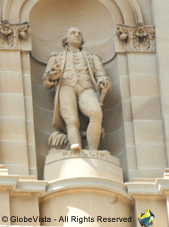Statue of Arthur Phillip

Public Art: Arthur Phillip statue
Sculptor: ©
Description: The sandstone carving of Arthur Phillip, the founder of Sydney, is one of 23 sandstone carved figures on the ledges of the Land Department Building. Arthur Phillip is depicted in his British Captain uniform, with right hand on his sword and left hand clenching a scroll.
Date Unveiled: c1891
Location: The statue of Admiral Arthur Phillip is located in a niche on the Bridge Street facade of the Department of Lands Building, Bridge Street, Sydney, Australia.
So who was Arthur Phillip? : Captain Arthur Phillip (11 October 1738 – 31 August 1814) was appointed Governor of New South Wales, the first European colony on the Australian continent, and was the founder of the site which is now the city of Sydney.
When Captain Arthur Phillip arrived in Botany Bay (First Fleet), on 18 January 1788, following eight months at sea, he was none too amused with the location recommended by Joseph Banks. The bay had inadequate anchorage and inadequate water supply for the hundreds of disgruntled passengers (and livestock), so he set out with a party of officers in a small boat to find a more suitable location. They eventually found the perfect harbour and Phillip christened it Sydney Cove, after the British Home Secretary, Thomas Townshend, Lord Sydney, in recognition of Lord Sydney’s role in issuing the charter authorising Phillip to establish a colony.
Despite better conditions, the settlement struggled. They had virtually no food and the convicts, who had no knowledge of agriculture, were reluctant to work as farm labourers. This was made even worse by the reluctance of many of the marines to discipline the convicts. Starvation was staring everyone in the face. Phillip had no choice but to negotiate with convicts and it soon became clear that for the colony to survive it could not be operated just as a prison camp. Meanwhile, military officers were demanding large grants of land, land which Phillip was not authorized to grant. The officers, who were expected to help grow food, refused, as they thought it was beneath them. It wasn’t long before the colony was suffering from scurvy.
In the early months Phillip, under instructions of King George III, was ordered to maintain a good relationship with the local Eora Aboriginal people. As a result he ordered that they be treated well and that anyone found killing one would be hanged. However, Phillip’s stance changed when his gamekeeper, John MacIntyre, was fatally wounded by an Aboriginal man. Despite MacIntyre confessing on his deathbed that he had been killing Aboriginals, Phillip ordered six aborigines to be captured and put to death in retribution.
In 1790 Phillip assigned the first land grant. It was given to a convict named James Ruse, who established the first successful farm at Rose Hill (now Parramatta).
The next couple of years proved hard for the colony as the arrival of the Second and Third fleet placed an enormous strain on food supplies.
Phillip, who by now was suffering from ill-health due to a poor diet, was desperate to return to England. On the 11th of December 1792, his wish was granted and he set sail for home taking along with him two indigenous friends, Bennelong and Yemmerrawanyea. The population of New South Wales by then 4,221, of whom over 3,000 were convicts.
After fully recuperating, Phillip returned to sea in 1796 where he eventually became a Rear-Admiral. He retired to Bath in 1805 after retiring from the Navy and died there in 1814.
Arthur Phillip Trivia: The remains of Arthur Phillip were lost by the Church of England and no one knows the location to this day. In 2007 Geoffrey Robertson QC declared it his life mission to find the location of Captain Phillip’s remains and have his bones returned to Australia, where he believes they will be better cared for.